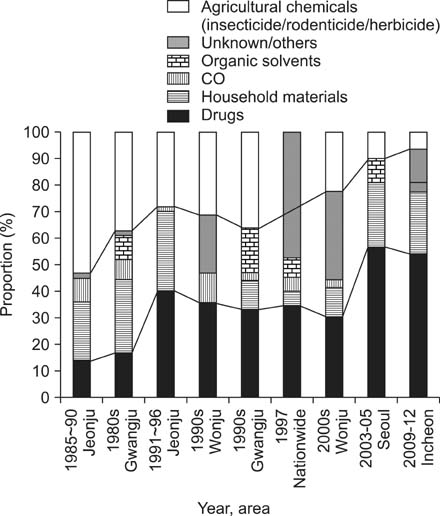Pediatr Gastroenterol Hepatol Nutr.
2013 Dec;16(4):233-239.
Poisoning in Korean Children and Adolescents
- Affiliations
-
- 1Department of Emergency Medicine, Gil Medical Center, Gachon University Graduate School of Medicine, Incheon, Korea.
- 2Department of Pediatrics, Gil Medical Center, Gachon University Graduate School of Medicine, Incheon, Korea. ryoo518@gilhospital.com
Abstract
- Drug intoxication in children and adolescents is not uncommon in Korea. But the tendency of intoxication is changing with some factors, such as national surveillance system, Naderism and increasing concern among physicians. But the death rate of intoxication among adolescents is increasing in spite of decreasing total death rate of intoxication among children and adolescents. Therefore the physician must be concerned about the basic management of intoxication and figure out the common toxic substance among children and adolescents.
Keyword
Figure
Reference
-
1. Wax PM. Historical principles and perspectives. In : Nelson LS, Lewin NA, Howland MA, Hoffman RS, Goldfrank LR, Flomenbaum NE, editors. Goldfrank's manual of toxicologic emergencies. New York: McGraw-Hill Companies;2011. p. 1–17.2. Warner M, Chen LH, Makuc DM, Anderson RN, Miniño AM. Drug poisoning deaths in the United States, 1980-2008. NCHS Data Brief. 2011; (81):1–8.3. Franklin RL, Rodgers GB. Unintentional child poisonings treated in United States hospital emergency departments: national estimates of incident cases, population-based poisoning rates, and product involvement. Pediatrics. 2008; 122:1244–1251.
Article4. Rossen LM, Khan D, Warner M. Trends and geographic patterns in drug-poisoning death rates in the U.S., 1999-2009. Am J Prev Med. 2013; 45:e19–e25.
Article5. Statistics Korea. Causes of death [Internet]. Daejeon: Statistics Korea;2012. accessed 2013 Nov 20. Available from: http://www.kostat.go.kr.6. Park CS, Eun SH, Yang MH, Son JA, Hwang JY, Ko JW, et al. A study of acute poisoning in Korean children. J Korean Pediatr Soc. 2001; 44:614–619.7. Kim DK, Choi KC, Jung EK, Yang ES, Moon KR. The clinical study of acute poisoning in children. J Korean Pediatr Soc. 1996; 39:1753–1758.8. Kong HP, Park KB, Lee OK, Park KS. The statistical study of patient with acute poisoning. J Korean Pediatr Soc. 1997; 40:1596–1602.9. Eum JP, Suh JS, Kim HM. Clinical analysis of acute drug intoxication and foreign body ingestion in Wonju: comparison between the 1990s and the 2000s. Korean J Pediatr. 2007; 50:138–142.
Article10. Suh JH, Eo EK. The differences of clinical aspects in children and adolescents poisoning. J Korean Soc Clin Toxicol. 2006; 4:17–24.11. Bronstein AC, Spyker DA, Cantilena LR Jr, Rumack BH, Dart RC. 2011 Annual report of the American Association of Poison Control Centers' National Poison Data System (NPDS): 29th Annual Report. Clin Toxicol (Phila). 2012; 50:911–1164.
Article12. Poison Information Center. Introduction of poison information center [Internet]. Seoul: Poison Information Center;2012. accessed 2013 Mar 18. Available from: http://www.poisoninfo.co.kr/main.do.13. O'Donnell KA, Ewald MB. Poisoning. In : Kliegman RM, Stanton BF, St. Geme JW, Schor NF, Behrman RE, editors. Nelson textbook of pediatrics. Philadelphia, PA: Elsevier Saunders;2011. p. 250–301.14. Barrueto F Jr, Gattu R, Mazer-Amirshahi M. Updates in the general approach to the pediatric poisoned patient. Pediatr Clin North Am. 2013; 60:1203–1220.
Article15. Ressel GW. AAP. AAP releases policy statement on poison treatment in the home. Am Fam Physician. 2004; 69:741–742.16. Singer J, Janz T. Apnea and seizures caused by nicotine ingestion. Pediatr Emerg Care. 1990; 6:135–137.
Article17. Tintinalli JE, Stapczynski JS. Tintinalli's emergency medicine: a comprehensive study guide. New York: McGraw-Hill;2011.18. Goldfrank LR, Hoffman RS. Goldfrank's manual of toxicologic emergencies. New York: McGraw-Hill Medical;2007.19. Chyka PA, Seger D, Krenzelok EP, Vale JA. American Academy of Clinical Toxicology. European Association of Poisons Centres and Clinical Toxicologists. Position paper: Single-dose activated charcoal. Clin Toxicol (Phila). 2005; 43:61–87.
Article20. Lo JC, Ubaldo C, Cantrell FL. A retrospective review of whole bowel irrigation in pediatric patients. Clin Toxicol (Phila). 2012; 50:414–417.
Article21. Burns MM. Activated charcoal as the sole intervention for treatment after childhood poisoning. Curr Opin Pediatr. 2000; 12:166–171.
Article22. Eddleston M, Juszczak E, Buckley NA, Senarathna L, Mohamed F, Dissanayake W, Ox-Col Poisoning Study collaborators, et al. Multiple-dose activated charcoal in acute self-poisoning: a randomised controlled trial. Lancet. 2008; 371:579–587.
Article23. Presley JD, Chyka PA. Intravenous lipid emulsion to reverse acute drug toxicity in pediatric patients. Ann Pharmacother. 2013; 47:735–743.
Article24. Kay M, Wyllie R. Caustic ingestions in children. Curr Opin Pediatr. 2009; 21:651–654.
Article25. Kim C, Kim DS, Lee HW, Ahn YM, Uhm JH. A case of grayanotoxin intoxication presenting with mental changes and vomiting. Korean J Pediatr Gastroenterol Nutr. 2008; 11:223–225.
Article26. Kwak BO, Bae SH. A case of hyperacute liver failure from mushroom intoxication in a child treated with penicillin. Korean J Pediatr Gastroenterol Nutr. 2008; 11:210–213.
Article27. Asan Medical Center. Korean wild plants [Internet]. Seoul: Asan Medical Center;2011. accessed Mar 14, 2013. Available from: https://itunes.apple.com/kr/app/hangug-ui-yasaengsigmul/id416043873?mt=8.28. O'Brien MC, McCoy TP, Rhodes SD, Wagoner A, Wolfson M. Caffeinated cocktails: energy drink consumption, high-risk drinking, and alcohol-related consequences among college students. Acad Emerg Med. 2008; 15:453–460.29. Lim HO. Energy drink safety condition investigation [Internet]. Seoul: Korea Consumer Agency;2013. accessed 2013 Nov 15. Available from: https://www.kca.go.kr/modules/board/view.jsp?&boardConfigNo=154&menuNo=307&boardNo=38067.30. Seifert SM, Seifert SA, Schaechter JL, Bronstein AC, Benson BE, Hershorin ER, et al. An analysis of energy-drink toxicity in the National Poison Data System. Clin Toxicol (Phila). 2013; 51:566–574.
Article31. Wolk BJ, Ganetsky M, Babu KM. Toxicity of energy drinks. Curr Opin Pediatr. 2012; 24:243–251.
Article
- Full Text Links
- Actions
-
Cited
- CITED
-
- Close
- Share
- Similar articles
-
- Retrospective Analysis on the Clinical Differences of Children and Adolescents Treated for Acute Pediatric Poisoning in an Emergency Department?
- Clinical features of adolescents with suicide attempt and the factors associated with their outcomes: poisoning versus non-poisoning
- Analysis of Characteristics in Children and Adolescents with Poisoning at Emergency Department
- Metabolic syndrome in children and adolescents
- Current Phenomenon of Self-Harm in Children and Adolescents


